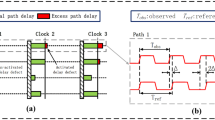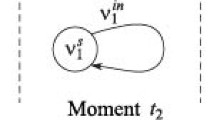Abstract
Delay testing is important for high speed ICs. The main difficulty in delay testing comes from the huge number of paths and the large percentage of delay untestable paths. Therefore, it is critical to reduce the number of paths to be tested in delay testing. This paper presents two approaches to delay testing with significant reduction of number of paths to be tested, which provide high path delay fault coverage by testing a small number of paths. In the first approach, it is necessary to sample the primary output twice, one before and another after the transition for each test pair. The second approach is by means of accurate measurement of delays of very limited number of paths. In order to make this approach feasible, the paper also introduces a new concept of path sensitization, termed single-transition sensitization, to allow direct measurement of propagation delay of those paths. The paper presents how to select the very limited number of paths, termed sample paths, and how to generate test pairs and observation times for the sample paths for the first approach. On the other hand, it is noted for the second approach that under the analytical delay model (Proc. 9th International Conf. on VLSI Design, Bangalore, India, Jan. 1996, pp. 162–165), most of the paths are delay testable, which makes the accurate measurement approach feasible. In fact, it would be very difficult to select sample paths based on single path sensitization as it was done in (IEEE Trans. on Computers, Vol. c-29, No. 3, pp. 235–248, March 1980). The paper shows that the number of sample paths is linear to the number of gates in the circuit under test, despite exponential growth in the number of single paths.
Similar content being viewed by others
References
J.D. Lesser and J.J. Shedletsky, “An Experimental Delay Test Generator for LSI Logic,” IEEE Trans. on Computers, Vol. c-29, No. 3, pp. 235-248, March 1980.
J.J. Shedletsky, “Delay Testing LSI Logic,” RC 6828, IBM T.J. Watson Res. Cent, York town Heights, NY, Oct. 4, 1977.
J.L. Carter, V.S. Iyengar, and B.K. Rosen, “Efficient Test Coverage Determination for Delay Faults,” Proc. 1987 Intl. Test. Conf., Sept. 1987, pp. 418-427.
I. Pomeranz and S.M. Reddy, “An Efficient Non-Enumerative Method to Path Delay Fault Coverage,” Proc. Intl. Conf. on Computer-Aided Design, 1992, pp. 560-567.
W.-N. Li, S.M. Reddy, and S.K. Sahni, “On Path Selection in Combinational Logic Circuits,” IEEE Trans. on Computer-Aided Design, pp. 56-63, Jan. 1989.
W.K.C. Lam, A. Saldanha, R.K. Brayton, and A.L. Sangiovanni-Vincentelli, “Delay Fault Coverage and Performance Tradeoffs,” Proc. 30th Design Autom. Conf., 1993, pp. 446-451.
Y. Min, Z. Li, and Z. Zhao, “Boolean Process,” Science in China, Series E, Vol. 40, No. 3, pp. 250-257, June 1997.
I. Pomeranz and S.M. Reddy, “On the Number of Tests to Detect All Path Delay Faults in Combinational Logic Circuits,” IEEE Trans. on Computers, Vol. 45, No. 1, pp. 50-62, Jan. 1996.
W.B. Jone and Y.P. Ho, “Delay Fault Coverage Enhancement Using Variable Observation Times,” Journal of Electronic Testing: Theory and Applications, Vol. 5, pp. 131-146, 1997.
H.C. Wittmann and M. Henftling, “Efficient Path Identification for Delay Testing-Time and Space Optimization,” Proc. European Design & Test Conf., Feb. 1994, pp. 513-517.
G.L. Smith, “Model for Delay Faults Based Upon Paths,” Proc. Intl. Test Conf., Nov. 1985, pp. 342-349.
C.J. Lin and S.M. Reddy, “On Delay Fault Testing in Logic Circuits,” IEEE Trans. on Computer-Aided Design, pp. 694-703, Sept. 1987.
E.S. Park, M.R. Mercer, and T.W. Williams, “The Total Delay Fault Model and Statistical Delay Fault Coverage,” IEEE Trans. on Computers, Vol. 41, pp. 688-698, June 1992.
W. Long, Z. Li, S. Yang, and Y. Min, “Memory Efficient ATPG for Path Delay Faults,” Proc. ATS'97, Japan, 1997, pp. 326-331.
Y. Min, Z. Zhao, and Z. Li, “An Analytical Delay Model Based on Boolean Process,” Proc. 9th International Conf. on VLSI Design, Bangalore, India, Jan. 1996, pp. 162-165.
Rights and permissions
About this article
Cite this article
Li, H., Li, Z. & Min, Y. Reduction of Number of Paths to be Tested in Delay Testing. Journal of Electronic Testing 16, 477–485 (2000). https://doi.org/10.1023/A:1008368615938
Issue Date:
DOI: https://doi.org/10.1023/A:1008368615938




